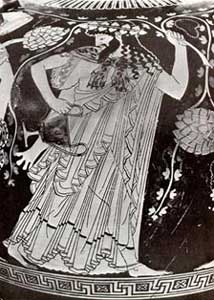
Dionysos carrying grape vine during Oschophoria
The
cult of Dionysos
Athenian festivals
See:
reference to Attic village of Ikaria
In contrast to his role in myth, the cultic Dionysos is largely a benevolent
god of fertility, wine, and good cheer. His festivals took place in the autumn,
winter, and early spring, the period from the harvesting of grapes to the
opening of the new wine.
Oschophoria
The name of the festival means "carrying of the vine-branches."
Two noble young men of the clan Salaminioi, dressed in women's clothes, carried
grapevines with the grapes still on them, in a formal procession, accompanied
by singing, to a special area called the Oschophorion at the shrine of Athena
Skiras. There were songs and dances, which we are told were both cheerful and
sad.
The celebration took
place on the seventh of the month Pyanopsion (~October, the "month
of bean porridge", a dish prepared for Apollo), at the time the grapes
were harvested and pressed to make wine. The seventh day was Apollo's day and
apparently also the day when Dionysos took over the sanctuary at Delphi from
Apollo for the winter months. Dionysos was said to be in terrible pain during
the winter, when most living things sicken and die, or hibernate.

Dionysos carrying
grape vine during Oschophoria
Rural
Dionysia
This festival took place during the month Poseidon (~December, Poseidon's
month), at various times in the various demes (villages) of Attica, the countryside
around Athens.
A feature of the celebration was a procession in which a large model of a phallos
(a male organ) was carried along, accompanied by a noble lady serving as Basket-Bearer
with a basket of raisins or other fruit. A Billy-goat was led along to be sacrificed
to Dionysos.
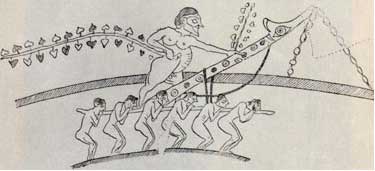
Phallus in procession
Lenaia
The Lenaia took place in Athens on the twelfth of Gamelion (~January,
the "month of marriage"). Its name may mean "festival of the
winepress" but more likely means "festival of the Maenads", another
name for whom is lenai. The sanctuary where it was held, the Lenaion, has not
been located.
Dionysos was worshipped here in the form of a mask atop a wooden column
bedecked with branches.
Many vases show women ecstatically worshipping such an idol. Lit torches sometimes
indicate a night-time ceremony. Some scholars interpret these vases as illustrations
of the rites of the Lenaia, but there is no way of being certain about this.
The scenes could be purely mythical.
The Lenaion may have been the earliest shrine of Dionysos at Athens, and the earliest tragedies and comedies may have been performed here, before the Theatre of Dionysos was built. The City Dionysia became the main festival for the performance of drama, but tragedies and comedies were also put on during the Lenaia. One of these was Aristophanes' Acharnians. Only Athenians could be present for these performances; no one from another city could attend.
At Delphi, a group
of Maenads called Thyiades ("raving women") roamed Mount Parnassos
in a midwinter celebration of Dionysos. As late as the first century CE they
got stuck in a blizzard and had to be rescued.
Every second year, the Delphic women were joined by women from Athens. The Lenaia
may have been the "home" festival for these Athenian women.
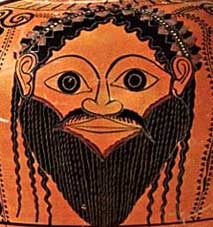
Mask of Dionysos - c 520 BCE
Anthesteria
The Anthesteria ("festival of flowers") also called the Older Dionysia
was celebrated on the 11th, 12th, and 13th of Anthesterion (~February,
"month of flowers") on the full moon preceding the City Dionysia.
This festival celebrated the second pruning of the vines and completion of the
second fermentation of the wine which was now ready to drink. Before the City
Dionysia was established, this was the last of the winter celebrations of Dionysos
at Athens.
On this occasion rituals centred on the sanctuary of Dionysos in the Marshes,
whose location within the city has not been discovered.
This was the time when new wine was ready and the storage-jars were first broached.
It was also a time when the ghosts of the dead could roam the earth, a time
to celebrate children as they turned three years old, and a time to re-enact
the sacred marriage of Dionysos to the Queen of Athens.
Anthesteria was celebrated at the Limnaion, the Shrine of Dionysos in the Marshes,
whose location in Athens is not known. All other temples of the gods were closed
during Anthesteria.
Day 1: Pithoigia ("Opening of the Wine-Jars")
The first day of Anthesteria featured a procession in which Dionysos was brought
into Athens in a model of a ship mounted on a cart. The god may have been represented
by a celebrant wearing a mask.
There may also have been ritual abuse and obscenities shouted by celebrants
riding in wagons.
Little else is known about this day. The first of the wine was offered to Dionysos and presumably quite a bit of it was drunk.
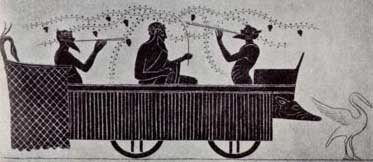
Dionysos in procession on a ship cart
Day 2: Choes ("Pitchers")
On this day everyone, including children, had their own pitcher or jug from
which they could pour wine to drink. Special markets were set up to sell these
vessels. A standard chous (the singular of choes) held nearly three quarts,
but some of the jugs were smaller, and in any case the Greeks normally diluted
their wine with several parts of water.
Children who had turned three were crowned with flowers and given their own
little jugs. (Some of these have been found in the graves of children who died
before they could take part in Anthesteria.) This was also a time to give toys
and pets to children.
Schoolteachers were paid their annual fee on this day (added gifts were welcome),
and in return they hosted receptions for their pupils.
The main event of Choes was the official drinking contest, with the priest
of Dionysos as host in a building in the Agora. At the sound of a trumpet
the drinking began. All the invited guests were required to remain silent
while they drank.
This strange custom was explained by the myth that Agamemnon's son Orestes came
to Athens to seek purification after killing his mother Klaitaimnestra to avenge
her killing of Agamemnon. Since Orestes was ritually unclean, he could not be
given ordinary hospitality, but he could not be rejected either. So he was invited
to the drinking contest, but the usual good fellowship was forbidden. When the
contest was over, the winner got a full wineskin as a prize!
There were also drinking contests in private homes, with a cake as a prize.
In a departure from regular practice, everyone brought his own food and wine;
only wreaths, perfumes, and dessert were provided by the host.. Afterward the
guests carried their garlands, draped around their pitchers, to the shrine of
Dionysos in the Marshes and dedicated them to the god.
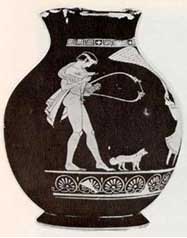
Tipsy winner of a drinking contest during Choes
Day 3: Chytroi
("Cooking-Pots")
It was probably on this day--actually on the evening of the day preceding, since
for the Greeks the new day began at sunset--that the sacred marriage or hieros
gamos was celebrated.
Dionysos was formally wedded to the Basilinna, wife of the Archon Basileus (King
Archon) i.e. the King surrendered the Queen to Dionysos. The bride was escorted
from the sanctuary of Dionysos in the Marshes to a building called the Boukoleion
("ox-herd building") in or near the Agora. Before the ceremony fourteen
noble women called Gerarai ("ladies of honour") made offerings at
fourteen altars in the sanctuary. The ceremony was strictly secret.
The wedding, evidently an ancient fertility rite, was explained by the myth that in earlier times the Athenian hero Theseus had to surrender his bride, the Cretan princess Ariadne, to Dionysos. The groom may have been the priest of Dionysos or the Archon Basileus, dressed and masked as Dionysos. Compare the marriage of Dionysos at Athens to his mythical reception at Thebes!
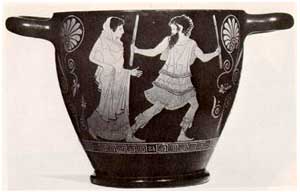
Satyr leading Basilinna - bride of Dionysos
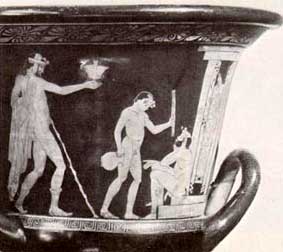
Arrival of Dionysos the groom
On the next day,
the actual day of Chytroi, vegetables were boiled and offered to Hermes
as Guide of Souls to the underworld. No living person partook of the feast.
Also on this day came Hydrophoria ("Water-Carrying") Young women carried
water to a chasm in the ground near the temple of Olympian Zeus, where it was
poured as an offering to those who had died in the great flood which Zeus once
sent to punish humankind. (Only two people survived, Deukalion and Pyrrha; they
became the ancestors of all the Greeks.)
Another event on this day was Aiora
("Swinging"). Masks were hung on trees, and children swung in
swings. This was apparently a rite of purification.

Satyr pushing girl or Nymph on a swing
IMPORTANT.....
The Athenians explained it with the myth that Ikarios, of the Attic
village of Ikaria, was given the vine by Dionysos. When he gave the
villagers wine, they thought they had been poisoned and killed Ikarios. His
daughter Erigone hanged himself from the tree under which her father lay. Athens
was then struck by a plague. The Delphic oracle prescribed the annual rite of
Aiora as recompense.
Altogether, the last day of Anthesteria was considered a day of ill omen. The
spirits of the dead were thought to be roaming the earth. People smeared their
doorways with pitch to keep them out, and they chewed a plant called buckthorn
to ward off their effects.
At the end of the day, and of the festival, the head of each household gave
a ritual shout: "Spirits begone, Anthesteria is over."
City Dionysia
The City Dionysia was held on the 9th to 13th of Elaphebolion (~March,
the "month of deerkilling"). The festival lasted for five days and
ended on the full moon (13th Elaphebolion) following the Spring Equinox
(that is the full moon preceding Easter - a feast day incidentally named after
the Germanic godess Eastre or Oestara). The
festival honoured Dionysos Eleuthereus, who had come to Athens from the border
village of Eleutherai, on the road to Thebes. As at the Lenaia, Dionysos took
the form of a column topped by a mask.
The festival is best known as the main occasion on which tragedies and comedies
(along with dithyrambs, choral songs honouring Dionysos) were performed in the
Theatre of Dionysos. It was probably established in the late sixth century BCE
to be the urban equivalent of the Rural Dionysia and the greatest and last of
the annual Dionysiac rites.
Since the weather
now made sailing possible, delegations from cities allied to Athens attended
the City Dionysia, in contrast to the other festivals of Dionysos.
The festival began with a torchlight procession in which the statue of
Dionysos Eleuthereus, which had been escorted from its shrine near the Theatre
to the Akademeia outside the city walls, was brought back. The Ephebes, young
men in military training, played a prominent role.
On the 10th came the main procession opening the City Dionysia. Many
sacrificial victims were paraded, especially bulls. (On one occasion, in the
fourth century BCE, 240 bulls were sacrificed.)
There were also many phalloi (models of male organs), some sent by cities
established as Athenian colonies.
This was an occasion for both the citizens and others living in Athens to assert
their civic identity. Metics (resident non-citizens) wore special scarlet
robes and carried trays of offerings. Citizens dressed as they pleased and carried
wineskins on their shoulders. People carried special loaves of
bread (long and thin, called obeliai). A young lady of noble birth was selected
to be Basket-Bearer.
The Choregoi, who took on the public obligation to pay for the tragic,
comic, and dithyrambic performances, paraded in splendid robes, sometimes
embroidered with gold.
The procession stopped at the shrines of various gods, where dances were performed.
Then came the main sacrifice at an altar near the Theatre.
Clearly this was a grander and more formal version of the procession which had
taken place during the winter at the Rural Dionysia in the various villages
of Attica.
The final event of this day was a komos
or revel (cf. komodia, "comedy"), hardly unique to this festival.
In the evening, bands of revellers roamed the city with torches, auloi (reed
instruments), harps--and wine.
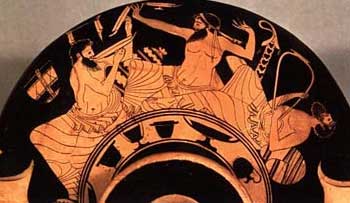
Symposion - the komos was a mobile version of this
Before the theatrical
performances began, the choregoi and their troupes of performers were presented
to the public in the Odeion of Perikles, next to the Theatre of Dionysos. (This
was called the proagon, or "pre-competition".)
The Theatre itself was purified by sacrificing a suckling pig (a frequent rite
of purification). Libations were poured by the ten generals (strategoi) whom
the Athenians elected annually.
While the Athenian Empire survived, the tax or tribute sent by the subject cities
was carried through the orchestra of the Theatre and presented to the audience.
The orphaned sons of soldiers killed in war, who had been maintained at public
expense until they reached military age, were paraded in the orchestra dressed
in the full armor which they had been given. A herald proclaimed their fathers'
distinction.
Also on this occasion, golden crowns could be awarded to civic benefactors.
And masters could have their slaves proclaimed free by a herald before the audience.
Although individual seats were not assigned, the arrangement of the spectators
(about 17,000 all told) probably reflected the role they played in the city:
the male citizens arranged by tribes in 10 of the 13 wedges into which the Theatre
was divided; women and resident foreigners at the sides; priests of the gods
and recipients of special honours in the front rows.
The plays were an integral and essential part of the festival, and the festival
was no less a part of the plays. Spectators arrived in the morning for a day
of drama; they brought wine and snacks to sustain themselves; and celebration
of Dionysos was very much a part of everything.
Dionysos at Athens: An Overview
These rites of autumn, winter, and spring show how Athens, in its annual calendar
of festivals, worshipped Dionysos. They included the vintage-celebration of
Oschophoria; the festive fertility-processions of the Rural Dionysia; the apparently
ecstatic Maenadism of the Lenaia, Anthesteria with its concern for new wine,
young children and the spirits of the dead, and its sacred marriage of Dionysos;
and finally the City Dionysia, established after the others as a culminating
civic event.
In cult, Dionysos was first and foremost a god of wine and fertility, but he
took on a greater importance for the people of Athens.
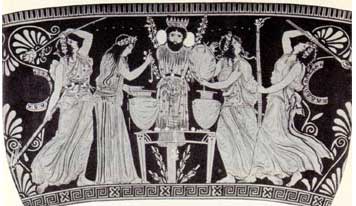
Maenads worshipping idol of Dionysos
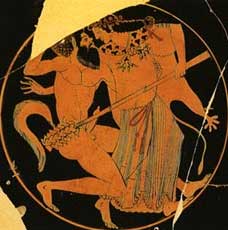
Satyr & Maenad
Acknowledgement: Hardy Hansen of Brooklyn College & other sources.